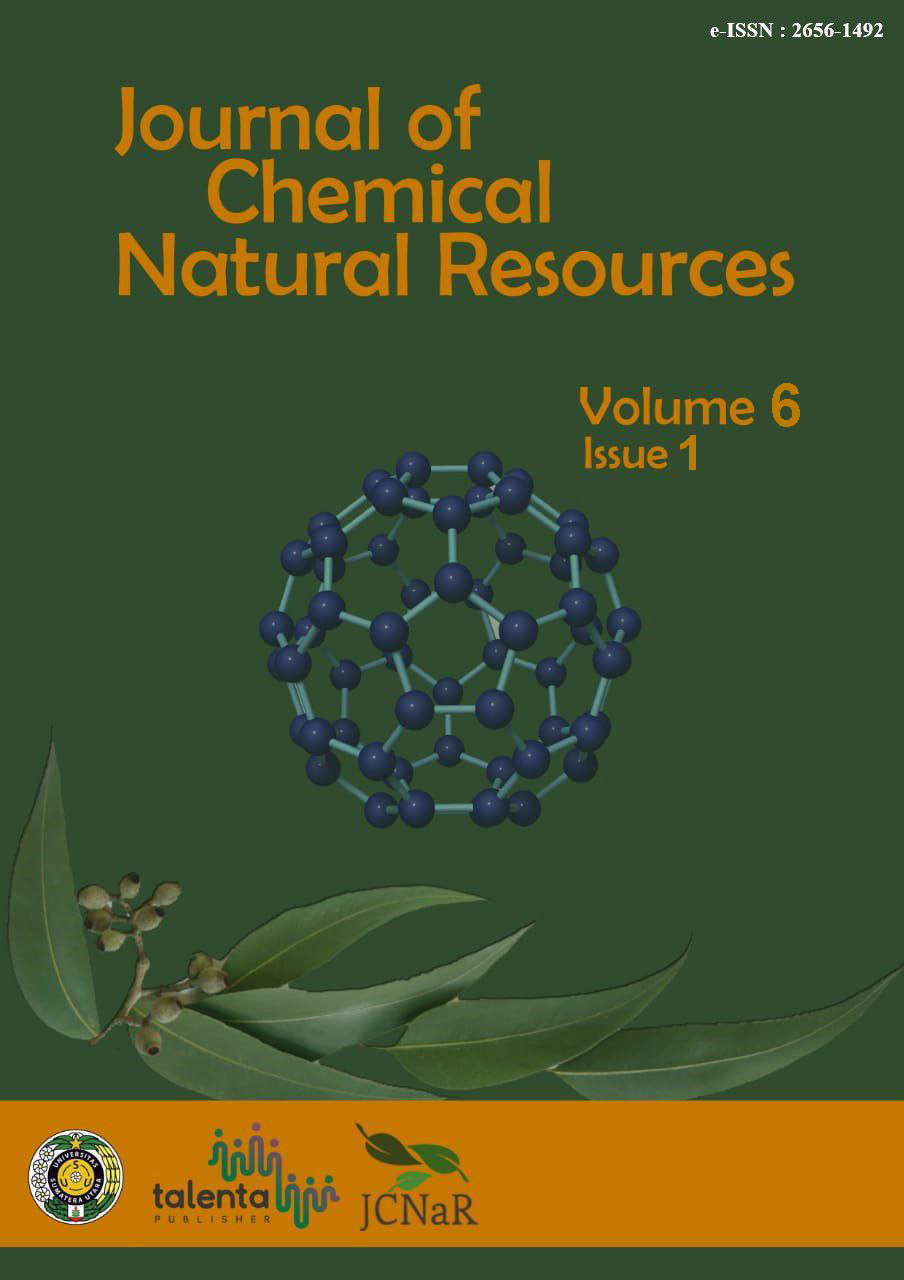Synthesis of Schiff Base through the Condensation Reaction Between Cellulose Dialdehyde with Ethylenediamine and Aniline as Well as Antibacterial Activity Test
DOI:
https://doi.org/10.32734/jcnar.v6i1.16224Keywords:
Antibacterial, Aniline, Cellulose, Ethylenediamine, Schiff BaseAbstract
Schiff base was created using a condensation reaction involving Ethylene diamine or Aniline and dialdehyde cellulose (DAC), which was obtained by oxidizing α-cellulose with sodium periodate as the oxidizing agent. The cellulose dialdehyde was identified through qualitative analysis, which involved observing the formation of a brick red sediment during the Fehling test and a rise in solubility in water. Additionally, the presence of an aldehyde group was confirmed by analyzing the FT-IR spectrophotometer data, which showed a peak at a wave number of 1635.64 cm-1. The synthesized dialdehyde cellulose has an oxidation degree of 80.9% and a carbonyl level of 10.36%. The Schiff base was analyzed using an FT-IR spectrophotometer, which revealed peaks at wave numbers 1635.64 cm-1 and 1604.77 cm-1. These peaks suggest the creation of a Schiff base bond (C=N) resulting from the condensation of the amine group from Ethylene diamine and Aniline with the aldehyde group from DAC. The antibacterial activity of Schiff bases was evaluated using the disc plate diffusion method. The Schiff base resulting from the condensation of DAC with Ethylenediamine at concentrations of 0.15%, 0.30%, and 0.45% was tested against S.aureus and E.coli. Clear zones of inhibition were seen, indicating the antibacterial effect. The Schiff base resulting from the condensation of DAC with Aniline at concentrations of 0.15%, 0.30%, and 0.45% showed clear zone diameters of 6.9 mm, 9 mm, and 12.5 mm against S.aureus and 7 mm, 12.5 mm, and 13 mm against E.coli. The clear zone diameters in a row were 10 mm, 10.8 mm, and 20.1 mm against S.aureus and 10.5 mm, 14.6 mm, and 17.1 mm against E.coli. The condensation of dialdehyde cellulose with ethylene diamine and Aniline leads to Schiff base formation. This Schiff base has antibacterial characteristics that are effective against S.aureus and E.coli.
Â
Downloads
References
S. P. Gautam, P. S. Bundela, A. K. Pandey, J. Jamaluddin, M. K. Awasthi, and S. Sarsaiya, “A review on systematic study of cellulose,†J. Appl. Nat. Sci., vol. 2, no. 2, pp. 330–343, 2010, doi: 10.31018/jans.v2i2.143.
J. T. McNamara, “A Molecular Description of Cellulose Biosynthesis,†Physiol. Behav., vol. 176, no. 3, pp. 139–148, 2017, doi: 10.1146/annurev-biochem-060614-033930.A.
P. Purohit, A. Bhatt, R. K. Mittal, M. H. Abdellattif, and T. A. Farghaly, “Polymer Grafting and its chemical reactions,†Front. Bioeng. Biotechnol., vol. 10, no. January, pp. 1–22, 2023, doi: 10.3389/fbioe.2022.1044927.
B. L. Tardy et al., “Deconstruction and Reassembly of Renewable Polymers and Biocolloids into Next Generation Structured Materials,†Chem. Rev., vol. 121, no. 22, pp. 14088–14188, 2021, doi: 10.1021/acs.chemrev.0c01333.
S. Doron, S; Gorbach, “Bacterial Infections : Overview,†Bacteriol. Amsterdam, Amsterdam, Netherlands, vol. 3, no. January, 2020.
Y. Roger, Dunia Microbe I. Jakarta: Penerbit Karya Aksara, 1982.
Z. Cimerman, N. Galic, and B. Bosner, “The Schiff bases of salicylaldehyde and aminopyridines as highly sensitive analytical reagents,†Anal. Chim. Acta, vol. 343, no. 1–2, pp. 145–153, 1997, doi: 10.1016/S0003-2670(96)00587-9.
D. Alonso, M. Gimeno, R. Olayo, H. Vázquez-Torres, J. D. Sepúlveda-Sánchez, and K. Shirai, “Cross-linking chitosan into UV-irradiated cellulose fibers for the preparation of antimicrobial-finished textiles,†Carbohydr. Polym., vol. 77, no. 3, pp. 536–543, 2009, doi: 10.1016/j.carbpol.2009.01.027.
L. Stepani, “Sintesis Basa Schiff melalui Kondensasi Aldehida Hasil Ozonolisis Metil Ester Asam Lemak Minyak Kelapa Sawit dengan Anilina dan Fenilhidrazin yang Berfungsi sebagai Bahan Anti Bakteri Maupun Inhibitor Korosi pada Logam Seng,†Universitas Sumatera Utara, 2015.
K. F. Hamak and H. H. Eissa, “Synthesis, characterization, biological evaluation and anti corrosion activity of some heterocyclic compounds oxazepine derivatived from schiff bases,†Int. J. ChemTech Res., vol. 5, no. 6, pp. 2924–2940, 2013, doi: 10.4172/2161-0401.1000121.
I. U. Scott, W. R. Green, A. K. Goyal, Z. de la Cruz, S. Naidu, and H. Moser, “New sites of ocular involvement in late-infantile metachromatic leukodystrophy revealed by histopathologic studies,†Graefe’s Arch. Clin. Exp. Ophthalmol., vol. 231, no. 3, pp. 187–191, 1993, doi: 10.1007/BF00920946.
S. M. A. S. Keshk, A. M. Ramadan, A. G. Al-Sehemi, E. S. Yousef, and S. Bondock, “Peculiar behavior of starch 2,3-dialdehyde towards sulfanilamide and sulfathiazole,†Carbohydr. Polym., vol. 152, pp. 624–631, 2016, doi: 10.1016/j.carbpol.2016.07.061.

Downloads
Published
Issue
Section
License
Copyright (c) 2024 Journal of Chemical Natural Resources

This work is licensed under a Creative Commons Attribution-ShareAlike 4.0 International License.














